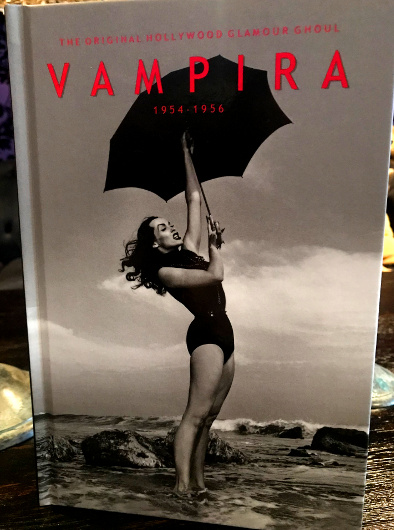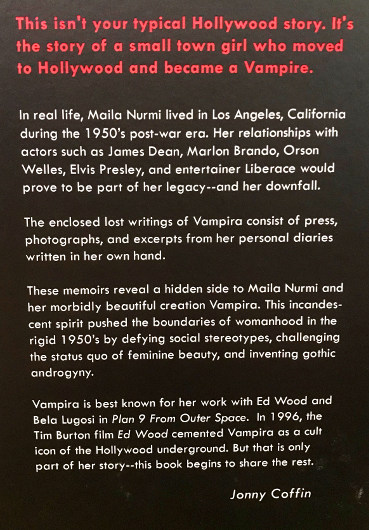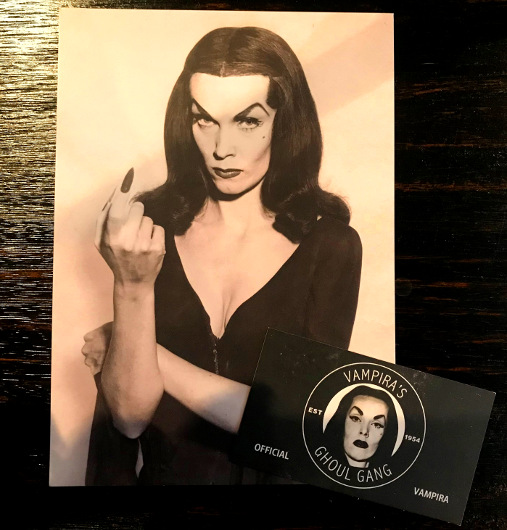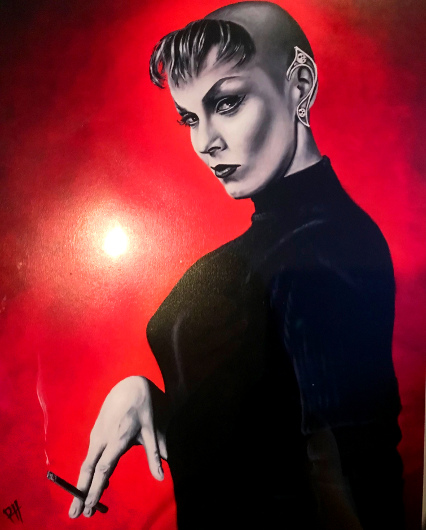
Before Elvira, Mistress of the Dark, there was Vampira, famously known as the original Glamour Ghoul. Her pale visage, raven-colored locks, crimson lips, and highly arched brows made her quite the image to behold on late-night television. While she’s revered today as an icon in the underground scene, her claim to fame was short-lived during her time.
In an all-new book called The Vampira Diaries: 1954-1956, author Jonny Coffin gives readers a closer look into the world of the queen of the night. Digging out archives from the grave, he presents a collection of unseen photographs, newspaper clippings and excerpts from her diaries, resurrecting the voice and presence of this dark soul. I recently finished the biography and want to share a bit of what lies on the pages.
Vampira was born Maila Nurmi on December 11, 1922, in Gloucester, Massachusetts, and lived a quiet, mundane life with her parents throughout her youth. The family left the East Coast and headed West, settling in Astoria, Oregon. Bored with the trivialities of her existence, she packed up and moved to Los Angeles in 1939. What ensued makes it evident Nurmi was ahead of her time, living in a world that didn’t understand or appreciate her eccentricities and open mind.
It was the 1940s, and like most young women at the time coming to Hollywood to become a starlet, she started off as a model. She was even booked on shoots with Marilyn Monroe, who was still going by her birth name, Norma Jeane. However, Nurmi wasn’t discovered for her pinup photo sessions. In 1953, she was invited to Revue Le Bal Caribe, a huge Halloween party attended by Hollywood’s elite, and won the costume contest. KABC producer Hunt Stromberg was one of the attendees and went on a mission to track the victor down.
It wasn’t long before the title of first “Horror Host” was bestowed upon her. At the stroke of midnight, KABC would air bizarre films, and to increase viewer ratings, the station came up with the idea to have them introduced by a seductive, mysterious siren. So, on April 30, 1954, Vampira made her grand debut on the small screen with the program, “Dig Me Later.”
The Glamour Ghoul would glide down a darkly lit, misty hallway, looking directly at the camera with a hypnotized stare. When she reached it, she would release a piercing scream, then smile mischievously. The host would engage the audience with her sinister sense of humor for a bit before the evening’s movie selection commenced.


Vampira was a hit, which was monumental considering the sexism against women that prevailed during the 1950s. That doesn’t mean people didn’t find her controversial, but she had enough devotees to make her a household name and catapult her into fame. From the book, I gleaned that she was inspired by the macabre cartoons Charles Addams drew for The New Yorker, which would later influence The Addams Family. Although the character wasn’t called Morticia at the time, it was the female persona that gave Nurmi the idea for her attire, and she made that point clear to the producers. The look inspired women across the country to imitate it, and she would receive fan mail with pictures of individuals dressed like her. I loved seeing these photos of females daring to cross over to the dark side.
She made several public appearances and reigned as TV’s morbid hostess, bewitching viewers. Sadly, after just a year, the show was canceled, but she garnered an Emmy nomination in 1955 for “Most Outstanding Female Personality.”
Don’t let the short lifespan of the show, however, fool you into thinking that there’s nothing more to Vampira’s story. The biography is a treasure trove of revelations about Nurmi, the individual. There are her writings about the relationship she had with Orson Welles, which, from how it appears to me, I think she may have had his baby, but you’d need to read the material yourself to understand my assumption.
She also had a very endearing platonic relationship with James Dean, who made a couple of appearances on Vampira’s show before he became famous. They had a special connection, and the book dives into how the media tried to blame her for his death because of strange synchronicities that happened leading up to his tragic passing. Nurmi was devastated when she found out Dean died, and all the more so when newspapers tried to make her out as the villain. Interestingly, she did attempt to contact Jimmy’s spirit by holding seances.
There are so many other fascinating facts, such as the real story behind the shaved head Maila donned after a trip to the beauty salon; her appearance with Bela Lugosi in Ed Wood’s Plan 9 From Outer Space; the connection to Maleficent in Disney’s Sleeping Beauty; and plenty more enticing accounts.
Vampira— the original Glamour Ghoul, first horror hostess and iconic vamp. Regardless of how brief her stint was on late-night TV in the 1950s, she’s risen from the dead, and her image thrives today among the living. She’s a fashion inspiration to goths everywhere (including myself), and a beloved figure in the Halloween, horror, vampire and alternative communities. Viva Vampira!
To snag your copy of The Vampira Diaries and other memorabilia, visit the official website.









Anyway, there goes my mind, completely blown away. Seriously, I always thought Elvira to be the original. No idea someone else created the persona, and nearly a generation earlier. Vampira, how could I not have heard of you until now?
That ignorance faded to black about half an hour ago, thanks to your (highly) fascinating post, Jenn. Thank you! Among all the ties to Hollywood legendry, and to the imagination they stir, none resonates more than does Vampira’s dedication to the Addams vision. Truly, Morticia a decade before she came to life (or is it to death?) on the TV screen.
What a life and, judging from your review, what a book too. Much appreciate the delectable feast you’ve prepared, Jenn! By the way, you’re Vampira’s worthy successor, not just in aesthetics, but more fittingly, in the eclectic and varied imagination you bring to the world.
Must be something in that SoCal water.
LikeLiked by 1 person
I couldn’t imagine filling Vampira’s shoes, but I’m very flattered by the comparison. And I’m so happy to have introduced you to her. Sadly, not much footage exists of her on TV, but if you want to learn more, check out a documentary called, “Vampira and Me.” It was fascinating! Thank you for reading the review!
LikeLiked by 1 person
Yes Vampira was an amazing personality and a great hostess.
If there had been no Vampira, there’d have probably been no Morticia and no Elvira Mistress of the Dark.
LikeLiked by 1 person
I completely agree! She brought light to the macabre feminine.
LikeLiked by 1 person
I’ve always been fascinated by (what I think of as) the glamour ghoul family tree; Vampira, Elvira, Morticia, there’s just something so hauntingly sexy about all of them, and so many people feel the same. I agree with the previous comment about how you really represent that theme stunningly, if you decide to start a YouTube channel to revive the trend, you can count me as a viewer 😉Goth is so beautiful and sensual, and it sounds like Vampira was a very complex woman. Great post, Vamp J!
LikeLiked by 1 person
That trio definitely embodies the glamour ghoul spirit! Thank you so much for the compliment. Now you got my wheels turning, haha! And I’m glad you enjoyed the post. Many thanks!
LikeLike
Love Vampira!
LikeLiked by 1 person
There’s no one like her! A true vamp.
LikeLike
I think I need this book immediately.
LikeLiked by 1 person
You’d really enjoy it!
LikeLiked by 1 person
Great review! This one’s gonna have to go on the TBR List for sure! 🙂
LikeLiked by 1 person
It’s a great read! I’m happy you enjoyed the review and thank you.
LikeLiked by 1 person